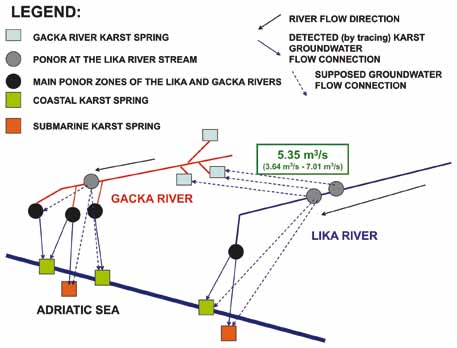Karst Rivers Hydrology: Case of the Lika and Gacka (Croatia)
DOI:
https://doi.org/10.3986/ac.v37i2.146Abstract
In this paper a case of very special hydrological behaviour of two neighbouring sinking karst rivers, Lika and Gacka, (Dinaric karst of Croatia), is analysed. The Lika River has a torrential hydrological regime. At the Sklope gauging station its minimum, mean and maximum measured discharges in the 1951-2005 period were: 0 (dry) m3/s : 24.5 m3/s : 729 m3/s. During the same period the Gacka River, at the Vivoze gauging station, had the following characteristic discharges: 2.29 m3/s; 14.7 m3/s; 71.0 m3/s. While the flow regime of the Lika River is characterised by extremely and very quick changes of discharges, the Gacka River flow regime is unusually uniform. The objective of the investigations made in this paper was to analyse the extremely different hydrological behaviour of the two neighbouring sinking rivers in order to find its reasons. Master depletion curves defined for the two analysed rivers shows that the karst aquifer of the Gacka River is much more abundant than Lika’s. The difference in the water temperature regime of the two neighbouring rivers is extremely high. At the Lika-Bilaj gauging station the minimum, mean and maximum measured water temperatures in the period of 1964-1991 were: 0.6°C; 9.3 °C; 21.4°C. During the period of 1964-2005 the Gacka River, at the Čovići gauging station had the following characteristic water temperatures: 6.4°C : 9.1°C : 11.6°C. The resident time in the karst underground of water discharging from the Gacka karst springs is much longer than in the case of the Lika River. The most probable explanation for this unusual hydrological behaviour of the two neighbouring karst rivers is that water from the Lika River and its catchment recharges some karst springs of the Gacka River. It is concluded that the Lika River feeds the Gacka River with an average annual discharge of about 5.35 m3/s. This value is different during each year and depends on the hydrological situation. It is very probably higher during the wet years than during the dry ones.
Downloads

Downloads
Published
How to Cite
Issue
Section
License
Authors guarantee that the work is their own original creation and does not infringe any statutory or common-law copyright or any proprietary right of any third party. In case of claims by third parties, authors commit their self to defend the interests of the publisher, and shall cover any potential costs.
More in: Submission chapter




